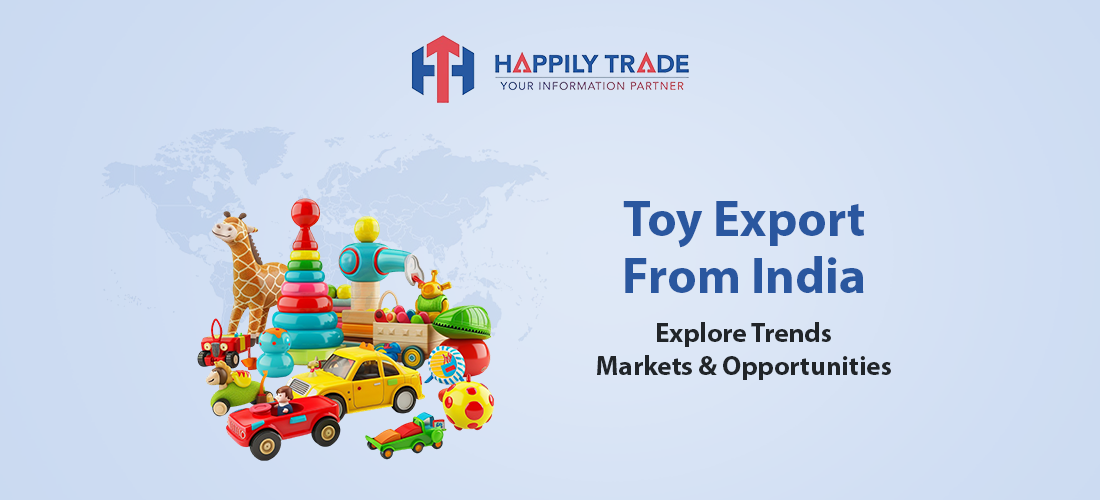How to Find Reliable Buyers for Toy Export from India
- Log in to post comments
India’s toy industry is experiencing a remarkable transformation, positioning itself as a key player in the global market. Toys export from India has grown significantly over the past few years, driven by government initiatives, increasing demand for high-quality and eco-friendly toys, and a shift towards local manufacturing. Once a major importer, India has become a competitive exporter, supplying toys to markets across the United States, Europe, and the Middle East. With evolving trends, innovative product development, and a focus on sustainability, India’s toy export sector is set for rapid expansion in 2025.
Overview of India's Toy Export Landscape
Historically, India's share in the global toy export market was minimal, accounting for just 0.3% in 2022, while China dominated with an 80% share. This gap was primarily due to China’s well-established manufacturing ecosystem, lower production costs, and extensive global supply chains. However, India has been steadily gaining ground, driven by strong government policies, increased focus on quality, and rising demand for locally manufactured toys.
Over the past decade, India has transitioned from being a net importer of toys to a rising exporter. The "Make in India" initiative and higher import duties on foreign-made toys have incentivized domestic production and reduced reliance on imports. Additionally, the Quality Control Orders (QCOs) introduced in 2021 set stringent safety and quality standards, ensuring Indian-made toys meet international benchmarks.
As a result, India’s toy exports have witnessed remarkable growth, rising from $40 million in 2014-15 to $152 million in 2023-24—a nearly fourfold increase. This surge is attributed to increasing global interest in eco-friendly, handcrafted, and educational toys, where India is uniquely positioned. Moreover, investments in automation, design innovation, and sustainable materials further enhance India's competitive edge in the global toy market.
With growing consumer preference for high-quality and ethically produced toys, India is well-positioned to expand its toy exports in 2025 and beyond. The focus now lies on strengthening manufacturing capabilities, improving supply chains, and fostering innovation to compete with established players in the industry.
HS Codes and Product Categories for Toy Export from India
Understanding the Harmonized System (HS) codes is essential for businesses involved in toy export from India. These codes categorize traded products, facilitating customs clearance and trade regulations. Some key HS codes relevant to the Indian toy export industry include:
- 9503: Tricycles, scooters, pedal cars, wheeled toys, dolls, etc.
- 9504: Video game consoles and machines, including parts and accessories.
- 9505: Festive, carnival, or other entertainment articles, including magic tricks and novelties.
- 9506: Equipment for general physical exercise, including toys designed for such activity.
- 9507: Fishing rods, lines, and other fishing tackle; hunting or target shooting equipment.
These categories encompass many toys, from traditional dolls and board games to electronic and educational games. The diversity in product offerings allows Indian manufacturers to cater to a global audience with varied preferences.
Growth Drivers for Toy Export from India
Several factors are propelling the growth of toy export from India:
- Government Support: Initiatives like the Production Linked Incentive (PLI) scheme for toy manufacturing and efforts to improve infrastructure and reduce bureaucratic hurdles create a favorable environment for businesses.
- Increasing Manufacturing Capabilities: Investment in modern manufacturing technologies and skill development is enhancing the quality and competitiveness of Indian toys.
- Growing Global Demand: The global toy market is expanding, and there's a rising preference for ethically sourced and sustainable toys, which India is well-positioned to provide.
- Focus on Innovation: Indian manufacturers are increasingly focusing on innovation, developing toys with educational value, incorporating technology, and catering to evolving consumer preferences.
- Competitive Pricing: India offers a competitive advantage in manufacturing costs, making its toys attractive to international buyers.
Emerging Trends in the Toy Export Industry
The toy industry is constantly evolving, and several key trends are shaping the future of toys export from India:
- Educational Toys: Demand for toys that promote learning and development is rising.
- Sustainable Toys: Eco-friendly toys from recycled materials or sustainable resources are gaining popularity.
- Tech-Enabled Toys: Technology incorporating augmented reality (AR) and artificial intelligence (AI) are becoming increasingly common.
- Personalized Toys: Customizable toys that cater to individual preferences are a growing trend.
- Digital Integration: The lines between physical and digital play are blurring, with toys increasingly integrating with digital platforms and apps.
Key Countries Importing Toy from India
As India's toy industry expands, several countries are emerging as significant buyers, strengthening the Indian sector's toy exports. With increasing global awareness of India’s manufacturing capabilities, diverse product offerings, and competitive pricing, the country is making inroads into new markets.
- United States: As one of the largest toy consumers, the US is becoming a crucial destination for toy exports from India. American buyers are increasingly sourcing from India due to the growing demand for high-quality, eco-friendly, and educational toys.
- European Union: Several EU countries, including Germany, France, and the UK, are actively importing Indian toys, particularly those that comply with stringent European safety and sustainability standards.
- Latin America: The demand for cost-effective and ethically produced toys is rising in Latin American countries, presenting new opportunities for Indian exporters.
- Southeast Asia: Close trade ties and geographical proximity make Southeast Asian countries a promising market for Indian toy exports, with growing interest in traditional and handcrafted toys.
- Middle East: Countries in the Middle East are expanding their imports of Indian toys, particularly in educational and premium-quality toy segments.
As global preferences shift towards sustainable and innovative toys, India's export footprint is expected to grow further in these key markets.
Growth Opportunities
India's toy exporting sector is witnessing tremendous potential for expansion, driven by strategic initiatives and evolving market demands. Several key opportunities can accelerate India's growth in the global toy industry:
- Diversification of Export Destinations: While the USA accounted for 39.1% of India's toy exports in 2022, there is significant potential to tap into European and Asian markets. Strengthening trade relations with countries in the EU, Latin America, and Southeast Asia can further boost export volumes.
- Government Support and Initiatives: The Indian government has introduced favorable policies, such as increasing the basic customs duty on imported toys to 70% and enforcing quality control orders (QCOs). These measures support domestic manufacturers and enhance the global competitiveness of toys exported from India.
- Investment in Technology and Innovation: Adopting advanced manufacturing techniques, automation, and research & development (R&D) can significantly improve product quality and design. Indian manufacturers increasingly focus on STEM-based educational toys, sustainable materials, and digital integration, making their offerings more attractive to international buyers.
Challenges Ahead
Despite the upward trajectory, several challenges remain for toy export from India, requiring proactive strategies to overcome them:
- Competition from Established Players: China continues to dominate the global toy market, making it crucial for Indian exporters to differentiate through innovation, sustainability, and quality assurance.
- Compliance with International Standards: Exporting toys to countries with strict safety and environmental regulations—such as the US and the EU—demands continuous improvements in materials, testing, and certification processes.
- Supply Chain and Logistics: Efficient logistics and supply chain management are critical for meeting delivery timelines and maintaining buyer confidence. Enhancing infrastructure, reducing lead times, and ensuring seamless international shipping will be key for sustaining growth.
Frequently Asked Questions
1. What is required to start exporting toys from India?
To start exporting toys from India, you need an Importer Exporter Code (IEC), BIS certification, GST registration, and compliance with international safety standards.
2. Which countries import Indian toys?
Major importers of Indian toys include the USA, UK, UAE, Germany, Australia, and Canada.
3. What certifications are needed for toy exports?
Toy exports need BIS (India), EN71 (Europe), ASTM F963 (USA), and CE Marking for compliance.
4. How can I find buyers for toy exports?
Find buyers through B2B platforms (Happily Trade Exim), trade fairs, and export councils (EPCH, FIEO).
5. What shipping method is best for toy exports?
Use air freight for speed, sea freight for bulk, and couriers for small shipments.








